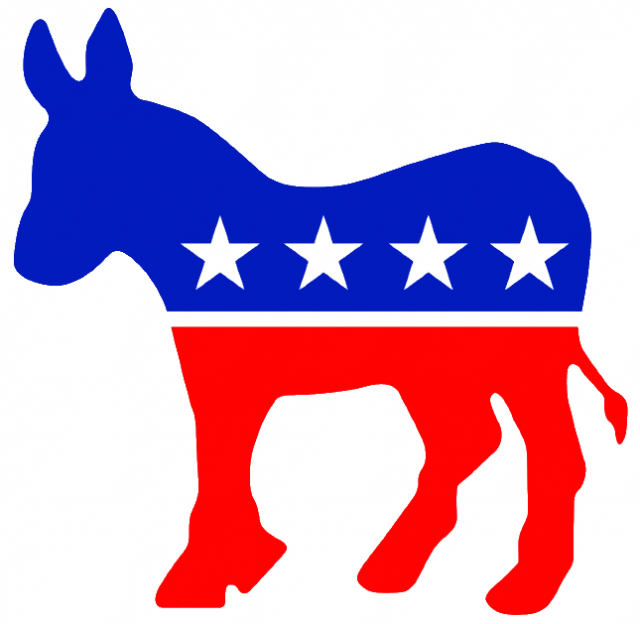Democrats Still Need a Clear Message
Yes, GOP gerrymandering matters. But they also have stronger candidates and message.

DemocraticLogo by Source. Licensed under Fair use via Wikipedia.
Dick Cates, a well-known Iowa County farmer, school board member, business consultant and member of U.S. Department of Agriculture advisory boards, wanted to be the Democratic candidate for southwest Wisconsin’s open Senate seat in 2014.
But then he met with a Democratic Senate leader. It didn’t go well.
Cates said he was told that party leaders would direct his campaign and, if Cates won, he would be expected to follow their lead on critical votes in the 2015-16 legislative session. That would be the price paid for Democratic leaders funneling cash, campaign workers and advice to a winning Cates campaign.
Cates felt that he couldn’t promise to blindly follow leaders he didn’t know, hadn’t earned his trust and who may care more about Milwaukee and Madison than southwest Wisconsin. So, Cates ended his Senate campaign, ran for the Assembly and lost to Republican Rep. Todd Novak by 65 votes.
Also losing was the Democratic candidate who Senate leaders finally recruited to run against Republican Sen. Howard Marklein.
Why tell this story?
Because the national controversy over whether legislative district lines Republicans drew in 2011 are constitutional focuses on just one part of the political stew that decides who serves in the Legislature.
Since forever, the party in control of Wisconsin’s Capitol has used new Census figures to draw legislative districts that help its current and future candidates. The only exception is when the out-of-power party sued, forcing federal judges to draw the final boundary lines. Federal judges, for example, drew district lines after the 2000 Census.
Sure, how Republican or Democratic voters are packed into new districts is important, and federal judges have ruled that Republicans drew the last lines in illegal ways that disenfranchised Democrats, starting with 2012 elections. The U.S. Supreme Court will decide that by next spring.
But three other factors also play big parts in deciding who does and doesn’t serve in the Wisconsin Legislature: Quality candidates. Candidates’ messages. Money.
Since 2010, Republicans have had better luck recruiting winning candidates for the Legislature. And, the winning GOP candidates in 2010 ran in districts drawn by federal judges.
GOP leaders have often recruited successful business executives who have retired or who have someone else make the day-to-day decisions for their businesses back home. The official resumes of most Assembly Republicans read like local Chamber of Commerce directories.
There is an age imbalance: 34 Assembly Republicans are older than 50 — more than twice the number of Assembly Democrats in that age bracket. Older voters show up at the polls in significantly higher numbers than younger ones.
You can disagree with the Republicans’ messages – limit the power of public employee unions, make government workers pay more for health care and pensions, legalize carrying concealed weapons, control property taxes, make Wisconsin a right-to-work state, etc. – but they have stuck with them. And, since 2010, they have had only one Messenger-in-Chief, Gov. Scott Walker.
Democrats are still looking for a simple, clear campaign message.
Last year, several Assembly Democratic candidates were energized acolytes of populist Sen. Bernie Sanders, who won the Wisconsin Democratic primary but lost the presidential nomination to the more traditional Hillary Clinton. Only one Bernie Baby Democrat got elected to the Assembly.
Wisconsin Democracy Campaign campaign-records (WDC) say that last factor – money – was equally distributed last year.
The election committees of legislative Republicans raised $2.8 million; Democrats, $2.5 million. The campaigns of Republican candidates raised $6.9 million; Democrats, $6.6 million. But independent spending by third-party groups favored Democrats, $4.8 million to $4.2 million, according to WDC records.
What’s it all mean? New maps of legislative districts alone – whether they are drawn for 2018, 2020 or 2022 elections – won’t guarantee Democratic victories.
Update of last column: The Wisconsin Elections Commission (WEC) last week directed its staff to develop electronic poll book software that can be used by local officials who want to switch from printed paper poll books to “e-poll books.” State law allows local officials to use e-poll books, but there is no requirement to change. WEC’s decision means e-poll books will be tested in the spring 2018 election and put into wider use starting in the August 2018 partisan primary election.
Steven Walters is a senior producer for the nonprofit WisconsinEye public affairs channel. Contact him at stevenscwalters@gmail.com
The State of Politics
-
RNC Brings Fame to Gen Z Party Leader
 Jul 15th, 2024 by Steven Walters
Jul 15th, 2024 by Steven Walters
-
Wisconsin’s Republican Roots Run Deep
 Jul 8th, 2024 by Steven Walters
Jul 8th, 2024 by Steven Walters
-
Feuding Supreme Court Justices Need a Break
 Jul 1st, 2024 by Steven Walters
Jul 1st, 2024 by Steven Walters




















Great article! The Dems need a message that resonates with moderates and Bernie supporters.